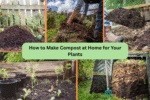There’s something magical about a field of wildflowers swaying in the breeze — a splash of natural color, a haven for pollinators, and a charming, low-maintenance way to beautify your landscape. If you’ve ever dreamed of turning part of your yard into a natural wildflower meadow, you’re in the right place!
Growing wildflowers is one of the easiest and most rewarding gardening projects you can undertake, even if you’re a beginner. With minimal care, you can enjoy vibrant blooms and support local ecosystems. In this article, we’ll break down 10 essential tips to successfully grow wildflowers — no green thumb required.

Why Grow Wildflowers?
Before we dig into the tips, let’s talk about why you should grow wildflowers:
- Low Maintenance: Once established, wildflowers thrive with little intervention.
- Pollinator-Friendly: Attract bees, butterflies, and hummingbirds.
- Drought Tolerant: Many wildflowers need less water than turf grass.
- Natural Beauty: Bring bursts of color and texture to your landscape.
- Eco-Friendly: Reduce lawn maintenance, watering, and chemical use.
Whether you’re dreaming of a small flower patch or a sprawling meadow, these tips will get you started right.

10 Tips to Grow Wildflowers for Beginners
1. Choose the Right Seeds for Your Region
The most important step to success is selecting wildflower varieties suited to your climate and soil. Native wildflowers will thrive naturally and support local wildlife.
How to Find the Right Seeds:
- Visit your local garden center.
- Search online for region-specific wildflower seed mixes.
- Contact your local extension service for recommendations.
Popular beginner-friendly wildflowers:
- Black-eyed Susan
- California Poppy
- Coreopsis
- Cosmos
- Blanketflower (Gaillardia)
- Coneflower (Echinacea)
Pro Tip:
Mix annuals (which bloom the first year) with perennials (which return year after year) for continuous color.

2. Pick a Sunny Spot
Most wildflowers love the sun. Choose a spot that receives at least 6–8 hours of direct sunlight daily for the best blooms.
Shady areas can work for select wildflower varieties like woodland phlox or violets, but for classic, meadow-style flowers, sunshine is essential.

3. Prep the Soil Properly
Wildflowers aren’t fussy about soil, but proper preparation helps improve germination rates and growth.
Steps to Prepare:
- Remove existing grass, weeds, and debris.
- Loosen the soil to a depth of 2–4 inches using a rake or tiller.
- Rake the soil surface smooth and level.
- Avoid adding rich compost or fertilizers — too-rich soil promotes weeds and floppy growth.
Optional:
If weeds are persistent, consider laying down a layer of cardboard for a few weeks to smother them before planting.

4. Plant at the Right Time
Timing matters when it comes to wildflower seeds.
Best Times to Plant:
- Spring (after last frost): Ideal for most regions.
- Fall (before first frost): Great for areas with mild winters — seeds stay dormant and sprout in spring.
Avoid planting during hot, dry summer months as seeds struggle to germinate without consistent moisture.

5. Scatter Seeds Evenly
For a natural-looking meadow, you don’t need to plant in rows. Instead, scatter seeds evenly by hand or use a seed spreader for larger areas.
Seed Scattering Tips:
- Mix seeds with dry sand or sawdust (about 4 parts filler to 1 part seed) to help distribute them evenly.
- Broadcast the mix over the prepared soil.
- Lightly press seeds into the soil with a rake or by walking over the area with flat boards attached to your feet.
Important:
Do not bury wildflower seeds deep; most need light to germinate.
6. Water Wisely
Watering is crucial during the germination period.
Watering Guidelines:
- Keep the soil consistently moist (but not soggy) until seedlings are 2–3 inches tall.
- Water lightly once or twice a day, especially in hot or dry conditions.
- After seedlings establish, reduce watering — most wildflowers are drought-tolerant.
Pro Tip:
Use a fine mist setting on your hose or watering can to avoid washing away tiny seeds.
7. Be Patient with Germination
Wildflower seeds don’t all sprout at the same time. Some will appear within a week, while others may take 2–4 weeks or longer.
Don’t worry if the area looks sparse initially. Germination time varies by species and soil temperature.
8. Thin Seedlings (If Necessary)
If seedlings grow too close together, thin them out gently to avoid overcrowding. This allows the healthiest plants to thrive and prevents diseases caused by poor air circulation.
How to Thin:
- Wait until seedlings have at least two true leaves.
- Snip excess seedlings at soil level rather than pulling them, which can disturb nearby roots.
9. Weed Carefully and Early
Weeds can outcompete delicate wildflower seedlings if left unchecked.
Tips to Control Weeds:
- Identify and hand-pull weeds early.
- Avoid disturbing the soil too much, as this can bring buried weed seeds to the surface.
- Mulching around wildflowers isn’t usually necessary but can help in bare patches.
10. Let Them Reseed Naturally
One of the greatest joys of wildflowers is how easily they self-sow for next year’s display.
After flowers fade:
- Leave seed heads intact for birds to enjoy and seeds to drop naturally.
- Collect seeds if you’d like to sow them elsewhere.
Optional:
Mow the wildflower patch on a high setting after seed drop in late fall or early spring to tidy it up and encourage new growth.
Bonus Tip: Mix Wildflowers with Grasses
For a more natural meadow effect, combine wildflower seeds with native ornamental grasses like little bluestem or switchgrass. Grasses provide structure, habitat for wildlife, and help support taller wildflowers.
Final Thoughts
Growing wildflowers is one of the simplest, most rewarding ways to add effortless charm and ecological value to your outdoor space. With minimal effort and the right approach, you can create a thriving, colorful haven for pollinators and people alike.
To recap:
Pick region-appropriate seeds
Choose a sunny, well-prepared spot
Plant at the right time
Water carefully and weed early
Be patient, and let nature do the rest!
Whether you dream of a cottage-style corner in your yard or a sprawling wildflower meadow, these beginner-friendly tips will set you up for a blooming success.



